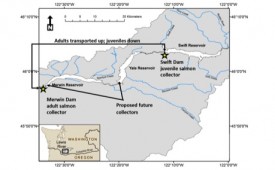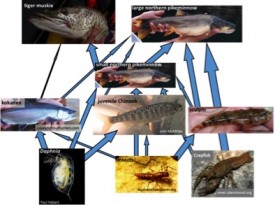BY Mark H Sorel, David A Beauchamp and Adam G Hansen, Washington Cooperative Fish and Wildlife Research Unit, School of Aquatic and Fisheries Sciences, UNIVERSITY OF Washington
Anadromous salmon and trout were blocked from a significant portion of their historic range in the North Fork Lewis River in southwest Washington when three hydroelectric dams were built between 1931 and 1958. This led to the collapse of a number of salmon stocks and increased reliance on hatchery production to maintain them. However, as part of their recent relicensing agreement with the Federal Energy Regulatory Commission, the owner and operator of the dams, PacifiCorp Energy, agreed to fund the construction and operation of infrastructure to pass salmon and steelhead around the dams. The first new fish collection and bypass structures went into operation in 2012, allowing spring Chinook, coho, and steelhead to access 120 miles of habitat in the upper watershed, located in the foothills of Mt. St. Helens and Mt. Adams.
The current system is “trap-and-haul,” which means that salmon are collected at the dams, loaded into fish trucks, and driven around the dams. Adult fish are driven around the middle two reservoirs and released into the upper watershed above Swift Reservoir. Salmon smolts are then captured in a floating juvenile salmon collector at Swift Dam and released below the dams. PacifiCorp is deciding whether to build two more fish collection systems above the lower two dams that would allow reintroduction into these reservoirs as well by 2016 (Figure 1).

Figure 1. Reservoirs on the North Fork Lewis River showing current and proposed salmon collection facilities for trap-and-haul transport of anadromous salmon and trout around the formerly impassable dams.
Our research aims to identify and understand the environmental and biological factors that could influence the success of such reintroductions within each reservoir and its tributaries, to help PacifiCorp and other stakeholders decide how best to implement additional salmon reintroductions.
Assessing reservoir conditions for salmonid survival
One of the objectives of our research is to evaluate whether the environmental conditions in each reservoir would be conducive to the growth and survival of juvenile salmon. The conventional view is that most juvenile salmon live in rivers and streams throughout their freshwater rearing, but there are numerous examples of juvenile spring Chinook and other salmon using lakes and reservoirs (Monzyk et al. 2013, Lowery and Beauchamp 2010, Koehler et al. 2006). Spring Chinook salmon generally spend one year growing in freshwater before they migrate to the ocean. Their growth during this first year is critical to their survival to adulthood, as it influences their risk of being eaten by predators and succumbing to disease or starvation (Sogard 1997). To evaluate the quality of the habitat and growth potential for juvenile salmon in Lewis River reservoirs, we examined the seasonal progression of water temperatures at different depths, and the food resources available to support the reintroduced populations of salmon. This requires consideration of when, where, and how much food is present, and how much is already being consumed by other species of fish that live in the reservoirs.

Figure 2. Food web diagram of Merwin reservoir showing potential prey, predators, and competitors of juvenile Chinook salmon.
We sampled vertical temperature profiles and zooplankton at three depth intervals (representing the epilimnion, metalimnion, and hypolimnion) monthly from April-November 2014. We also sampled fish seasonally to get information on their diet, growth, and distribution, and to identify potential competitors and predators of reintroduced salmon (Figure 2). Preliminary results indicate that all three reservoirs have moderate to high densities of Daphnia, key prey for salmonids in lakes and reservoirs (Figure 2). We are in the process of using bioenergetics models that account for seasonal changes in water temperature, growth, diet composition, and the energy density of predators and prey to estimate the amount of food eaten by fish that now live in the reservoir, and the amount of food needed to support the addition of juvenile salmon. Ultimately, we will estimate the number of salmon fry that the surplus food resources could support.
Assessing predation on salmonids
A major concern we are investigating is whether predation by northern pikeminnow in Merwin Reservoir could undermine the establishment of reintroduced salmon populations (Figure 2). Merwin Reservoir is thermally stratified from May through October. During this time, northern pikeminnow inhabit warmer surface waters within the epilimnion while salmonids (like resident kokanee and presumably juvenile Chinook salmon) generally occupy cooler waters within the metalimnion or deeper. These alternate distribution patterns appear to buffer juvenile salmonids from predation by northern pikeminnow for much of the growing season.
We examined stomach contents of northern pikeminnow and found that kokanee represented a relatively small fraction of the diet, in part because of their different spatial distributions during thermally stratified periods. The predatory threat of northern pikeminnow also depended on the size of the pikeminnow. Fish made up a higher proportion of the diet of northern pikeminnow larger than 12 inches, while individuals less than 12 inches long consumed mostly invertebrates.
With a mark-recapture study, we estimated that there were approximately 500,000 northern pikeminnow between 8 and 12 inches long and 11,000 northern pikeminnow greater than 12 inches in Merwin Reservoir. Even though the abundance of northern pikeminnow was high, a relatively small fraction of the population were of predatory size. This indicates that potential predation on reintroduced salmon is much lower than would be expected if the size-structure of northern pikeminnow were not taken into account.
The current consumption of kokanee by northern pikeminnow suggests that approximately 175,000 juvenile Chinook salmon would be consumed each year if they were introduced to the reservoir. If the northern pikeminnow instead focused their predation on year-old Chinook migrating through the reservoir to the ocean, we expect only 4,500 would be eaten.
Our preliminary findings suggest that, because pikeminnow and salmonids use different layers of the reservoir during warmer months, and because of pikeminnow size, the successful reintroduction of Chinook salmon into Merwin Reservoir would not be undermined by predation if juvenile fish use the reservoir as rearing habitat. Ongoing analyses of habitat quality and food availability are estimating the number of juvenile salmon that could be supported in Merwin Reservoir, to make sure that it is sufficiently greater than the number that would likely be lost to predation. Ultimately, test releases of Chinook salmon fry into tributaries of Merwin Reservoir are needed to more explicitly evaluate how the fish distribute and use reservoir versus stream habitat. Test releases would also allow us to examine how northern pikeminnow respond to the addition of Chinook salmon fry to the reservoir.
The Washington Department of Fish and Wildlife stocks roughly 1,000 tiger muskie (Figure 2) into Merwin Reservoir annually to control the northern pikeminnow population. In addition to studying predation by northern pikeminnow, we are looking into how the tiger muskie have affected the northern pikeminnow population. Tiger muskie may be playing a role in reducing the number of northern pikeminnow that survive to reach the predatory size of 12 inches or longer.
Conclusion
The reintroduction of salmon and steelhead above previously impassable dams is an exciting new restoration tool being proposed with increasing frequency as we work to recover or recreate runs of anadromous fishes. These projects have tremendous potential to help recover salmon in the Pacific Northwest given the prevalence of dams with high quality stream (and potentially reservoir) habitat above them. We hope that our research helps identify opportunities for successful reintroductions within the Lewis River and throughout the Northwest. We also aim to better understand potential constraints on reintroduced salmon populations and how to manage these projects to meet expectations.
References
Koehler, M.E., K.L. Fresh, D.A. Beauchamp, J.R. Cordell, C.A. Simenstad. 2006. Diet and bioenergetics of lake-rearing juvenile Chinook salmon in Lake Washington. Transactions of the American Fisheries Society. 135:1580-159
Lowery, E.D., and D.A. Beauchamp. 2010. Baseline food web assessment of the upper Clackamas River basin prior to reintroduction of bull trout. Final Report to the Upper Clackamas Bull Trout Working Group. Washington Cooperative Fish and Wildlife Research Unit Report # WACFWRU-010-02.
Monzyk. F.R., R. Emig, J.D. Romer, and T.A. Friesen. 2013. Life-history characteristics of juvenile spring Chinook salmon rearing in Willamette Valley reservoir. U.S. Army Corps of Engineers, Portland District – Willamette Valley Project.
Sogard, S. M. 1997. Size-selective mortality in the juvenile stage of teleost fishes: a review. Bulletin of Marine Science, 60(3): 1129-1157.









